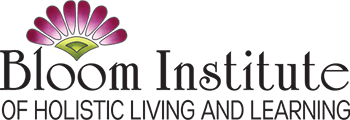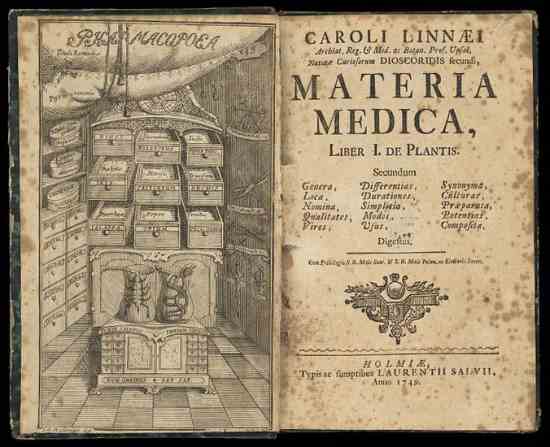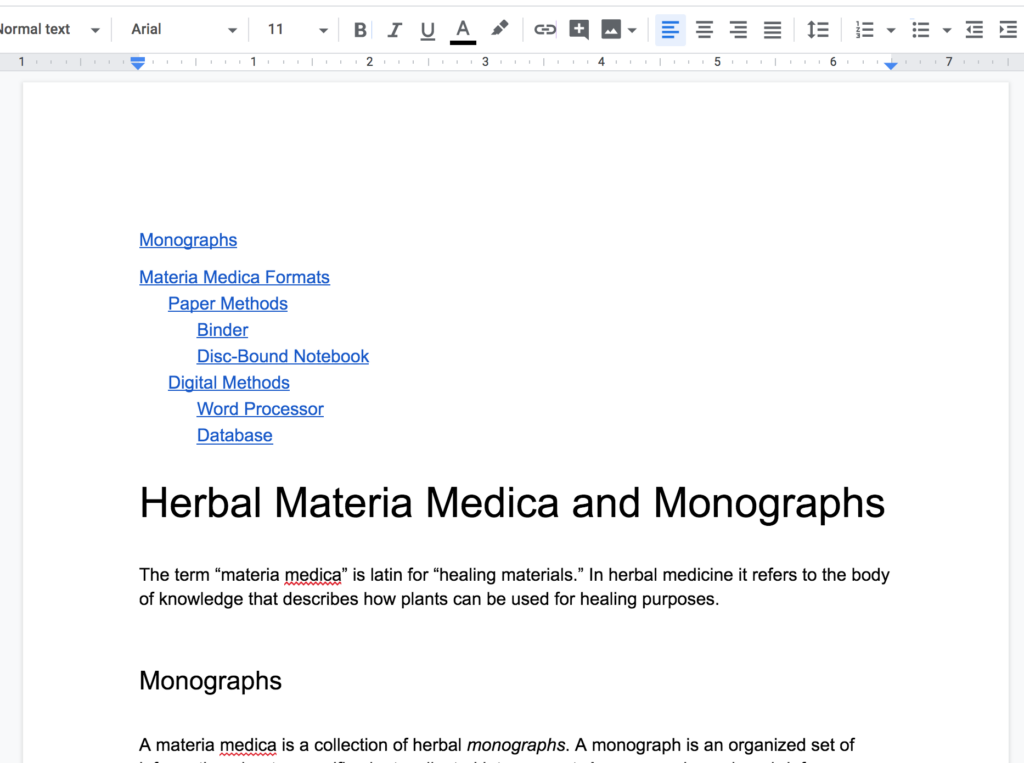The term “materia medica” is latin for “healing materials.” In herbal medicine it refers to the body of knowledge that describes how plants can be used for healing purposes. The term dates back to Roman times when Greek physician and botanist Dioscorides published a five-volume work called De Materia Medica. De Materia Medica was a widely used resource for 1500 years, until updated herbals were written in the Renaissance, one of which is Carl Linnaeus’ Materia Medica. (Linnaeus is the father of modern taxonomy, and the reason why we have standard, international botanical names.)
Monographs for your Materia Medica
A materia medica includes a collection of herbal monographs. A monograph is an organized set of information about a specific plant, collected into a report. A monograph can be a brief description of only a page, or it can be many pages. They often have the same key sections of information about the plant, including description, medicinal actions, growing habitat, and more.
It’s great to have a library of herbal reference books, but it’s even better to collect information about plants that you already have experience with, and grow your own personal materia medica as you gain first-hand experience with more and more plants. Reference books will have many plants that you haven’t used or don’t have access to, so I recommend collecting information about each plant that you do use, and have space in your materia medica to record your own observations as you meet the plant. Your senses can tell you a lot about the plant, so make room to record tastes, observations and experiences.
As you embark on a journey of herbal learning, it’s a good idea to start collecting monographs and expand your notes as you learn.
Here’s a long list of possible sections to consider including in your monographs, depending on your interests. Look through the list and make a template for yourself of the information that’s important to you.
[vc_row][vc_column width=”1/4″]
General
Name
Latin Name
Family
Safety
Description
Habitat
Harvest Month
Related Species
Geographic Range
Sustainability Issues
Harvesting Guidelines
[/vc_column][vc_column width=”1/4″]
Medical
Parts Used
Actions
Preparations
Uses
Doses
Tastes
Energetics
Key Constituents
References & Research
[/vc_column][vc_column width=”1/4″]
Cultivation
Zones
Soil
Size
Propagation
Siting
Problem Insects and Diseases
[/vc_column][vc_column width=”1/4″]
Other Information
Culinary Uses
Folklore
Magical Uses
[/vc_column][/vc_row]
Materia Medica Formats
So how should you collect all of this information?
The first decision is whether you want to collect the information in hard copy, or digitally.
A paper method is easy and versatile in that you can make it like a scrap-book. You can easily include , and The advantage of digital methods is that they are searchable and expandable. The downside is that it is not as tactile or accessible. It might be easier and more enjoyable for some people to simply keep a binder of monographs, and then easily add more pages.
Paper Methods
Binder
A binder is a cheap and easy way to collect pages, and you can easily expand your materia medica as your knowledge grows. Another pro is that there are page protectors and clear sleeves that you can use to keep recipe cards, magazine clippings or even pressed herbs.
Disc-Bound Notebook
A step up from a binder, which I prefer, is a notebook with disc binding. Setting up a disc-bound system is more expensive than just getting a binder because you need a special hole punch, but once you have the punch, you can add any page to a disc-bound notebook, just like you could to a binder.
The main advantage is that the cover can fold back on itself so it’s much easier to carry around and take notes. The other potential advantage is that there are many accessories available, if you like to customize your notebook. You can get rulers, pouches, dividers, sticky-notes and all sorts of things that snap into the special discs. There’s also a wide variety of covers available.
Disc-bound systems are available at Staples (called the Arc system) and at Michael’s (called Happy Planner). The Arc system is a good way to start; it’s simple and utilitarian.

Index Cards
Correne at Spirea Herbs loves her index card system. She uses a card per plant and keeps them all in a a box, like recipe cards. This method is great if know you’re only collecting notes, but it obviously can’t accommodate add-ons, like pressed flowers or large images.
Digital Methods
Word Processor
If you want your herbal monographs to be searchable, but you would also like to print them so you can flip through them easily, you can keep them all in one document. In Google Docs, you can have one long document with all your plant information, and if you use the built-in hierarchy of header formats (H1, H2, H3, etc) you can auto-generate a table of contents at the beginning that will automatically update when you add new plants and sections. Instead of scrolling, you can jump to the right section by clicking in the table of contents.
Database
I like disc-bound notebooks, but my absolute favourite method of collecting information is in a database.
If you’re a little bit tech savvy, you can collect your information in a database to make it easily searchable. Technically, the information in a database wouldn’t be a “monograph” because it’s a collection of information about several herbs, but the information in one record could be re-formatted into a monograph.
Database Terminology
A database is simply a structured method of organizing information on a computer.
A record is the collected information about one subject. The record contains fields, which are the categories of information about that record.
For example, you would have a record for each plant, and that record could contain fields of information such as Latin Name, Actions, Contraindications, Growing Habitat, etc.
The magic of a database is the versatility of organization. You can search for exactly what you’re looking for, and can arrange and visualize your records of plants in any way you want. You could search for a specific action or use, or for example, if you have a field for “Flower Colour” you could group your plants by flower colour, or if you have a field for “Harvest Month” you could arrange them by month.
My favourite database software is AirTable. It’s an easy, free, online database software. It looks similar to a spreadsheet, but has many options for field types and displaying your data. You can even insert images and view your database like a gallery.
Just to give you some inspiration of how you can organize information with AirTable, I found this Base of someone’s garden almanac and this one with someone’s seed records. You can easily create your own custom database for organizing your plant knowledge. You can even make a table to keep track of inventory or medicines you’ve made, all in one place.
To help get you started, I’ve made this Google Doc Materia Medica template for you. If you choose Google Docs as your method for your materia medica, you can just copy and paste the template over and over to add more plants to your list. Make sure to keep a blank template to copy at th ebottom of the document before you start filling it in. And you can, of course, delete any fields you don’t want to fill in.
And if you decide to make your materia medica in another medium, you can always use this as a reference for the kinds of information you might want to include.
The sooner you start collecting and organizing your plant data, the better! Your collection will grow and grow as you become familiar with more herbs, so it’s best to build a good foundation.
If you’re interested in building your herbal medicine knowledge, and developing a relationship for each of the plants that you study, consider enrolling in Holistic Herbal Wellness. The course is one day a month throughout a whole year so you’ll get dozens of monographs to build your collection, but more importantly, you’ll get out in the forests and fields to meet each plant in season.
The class starts in September. Register now if you’re planning on going, because you can get the early bird price until June 15th.



